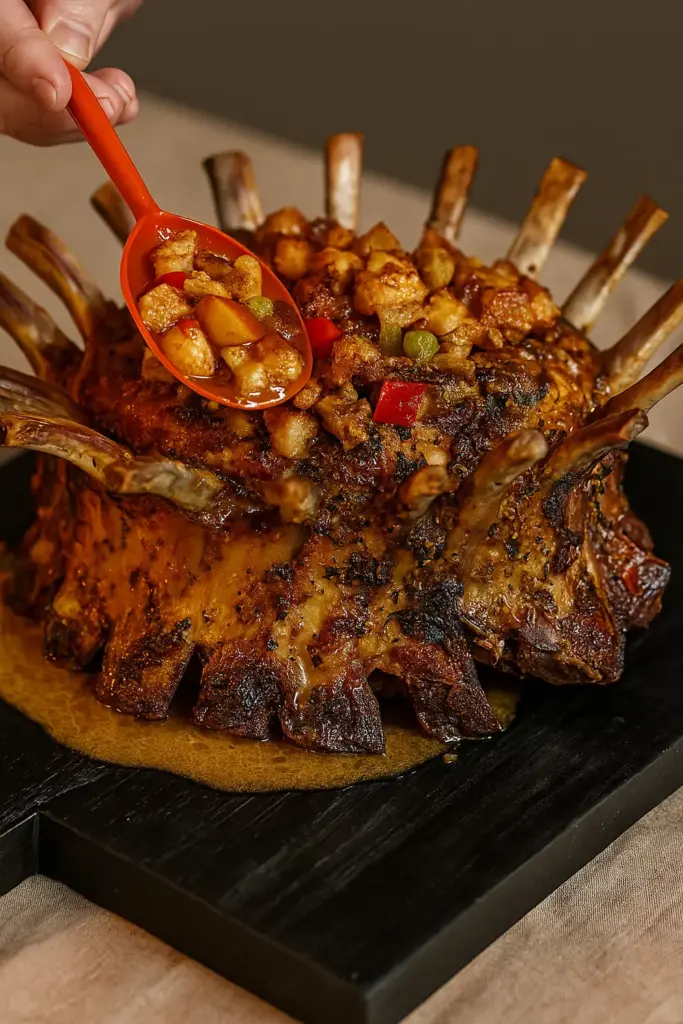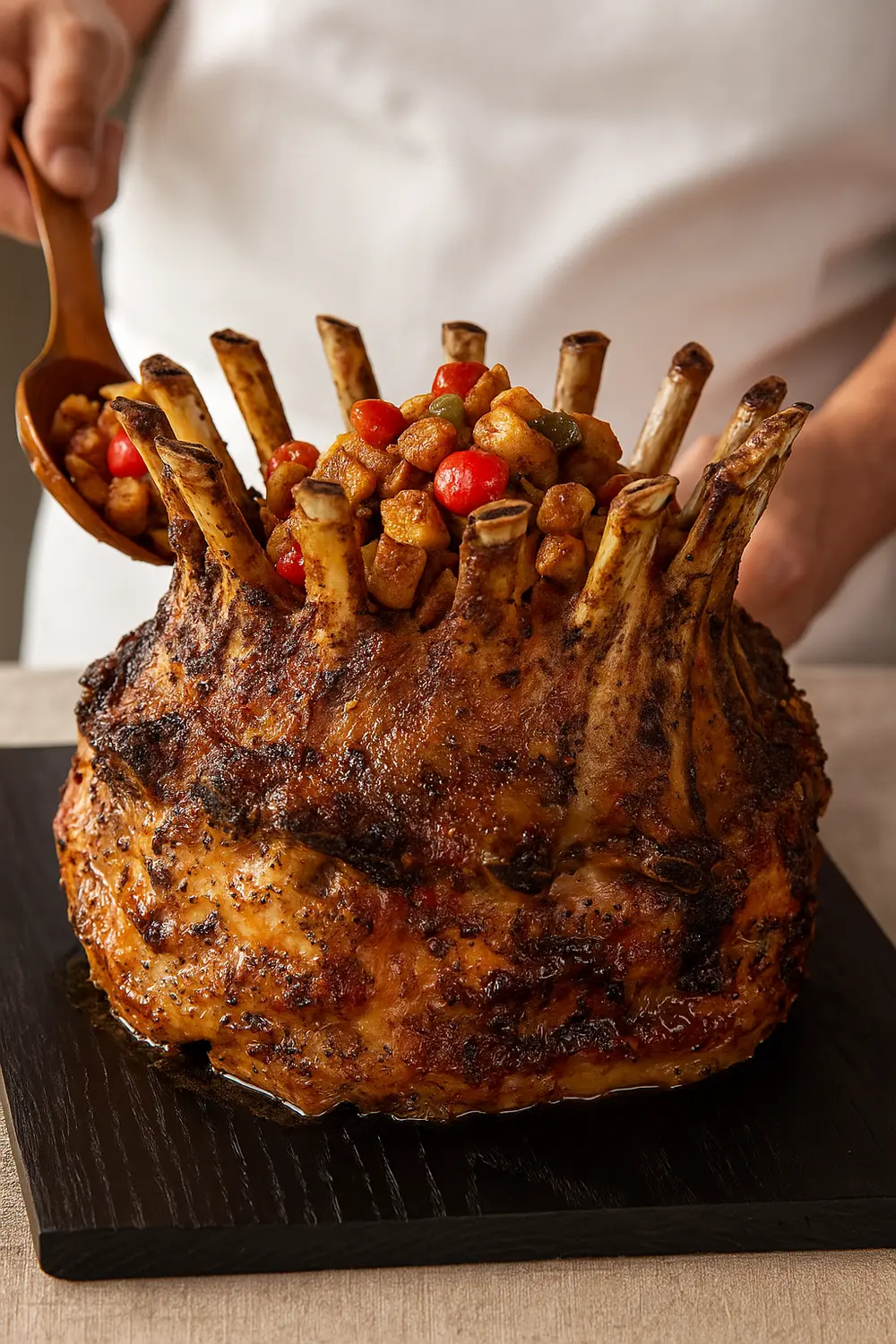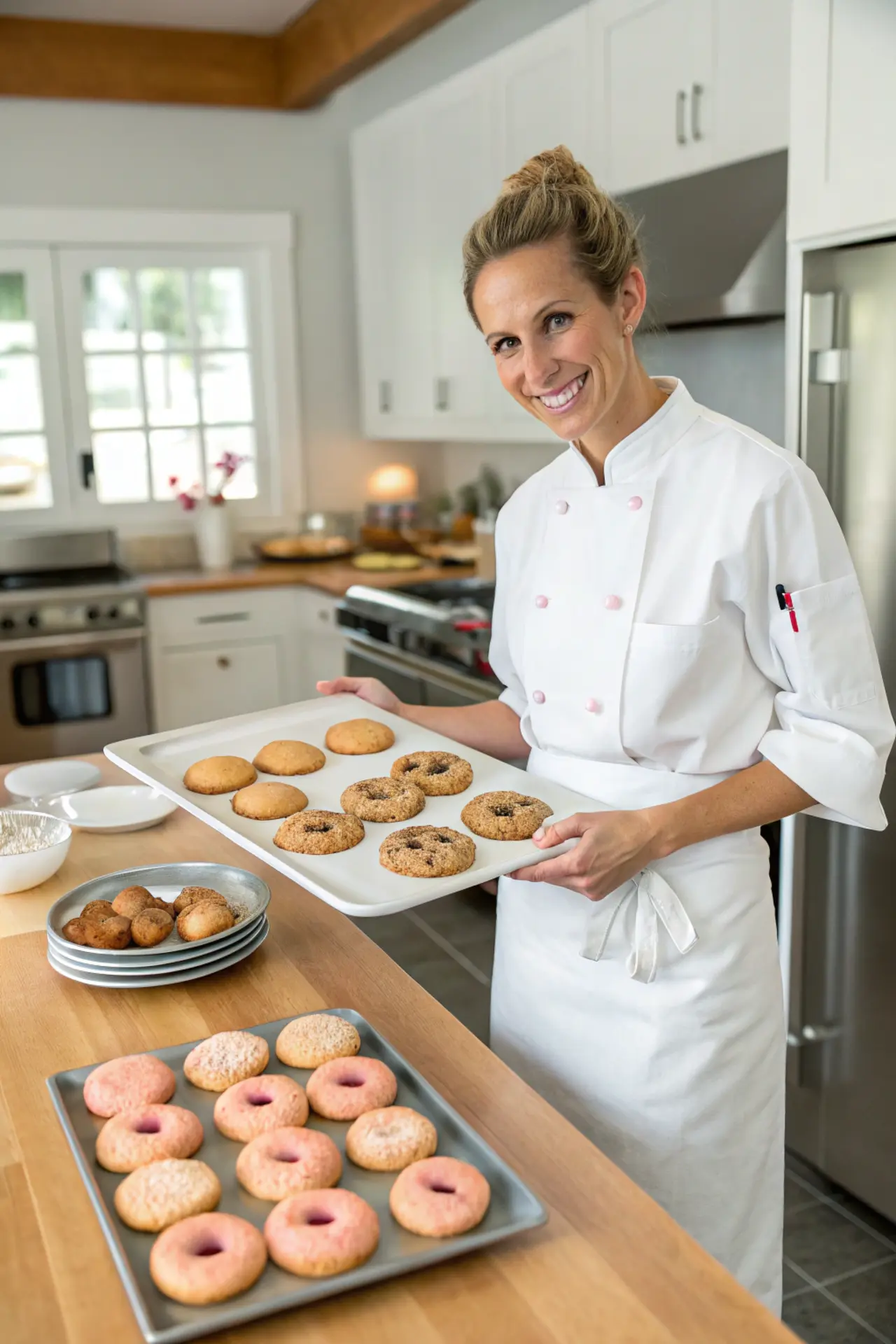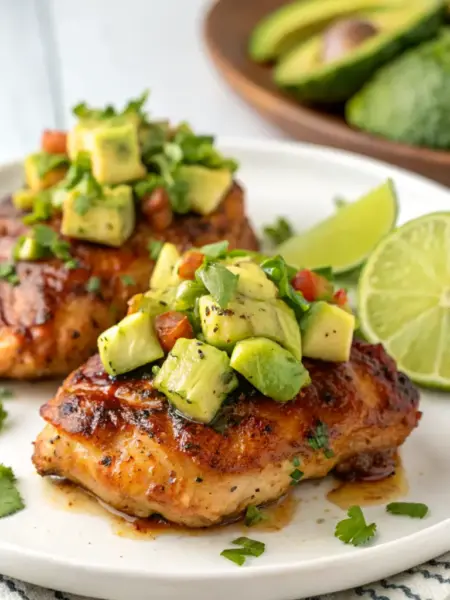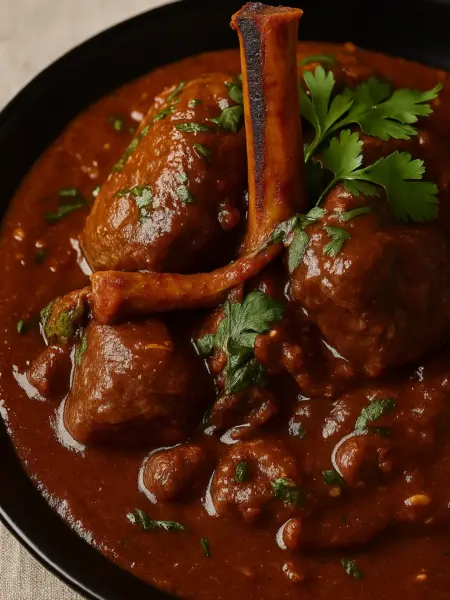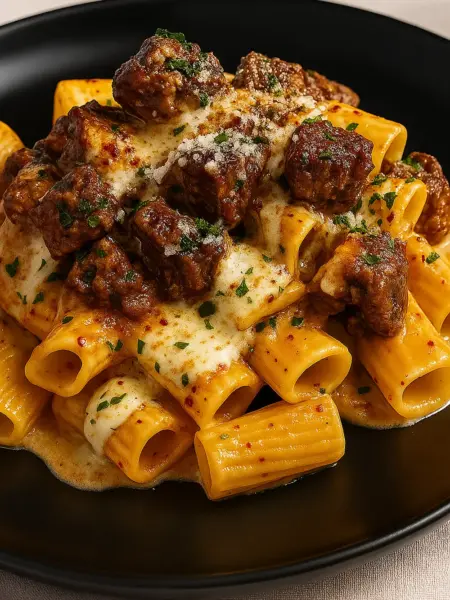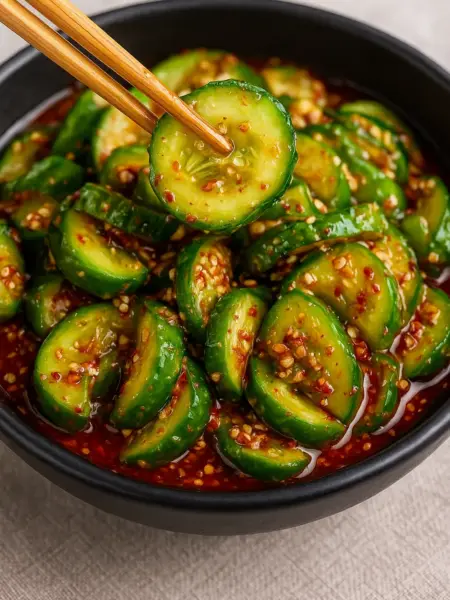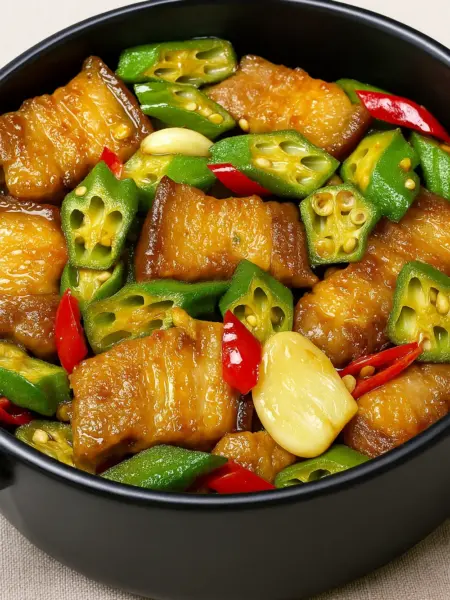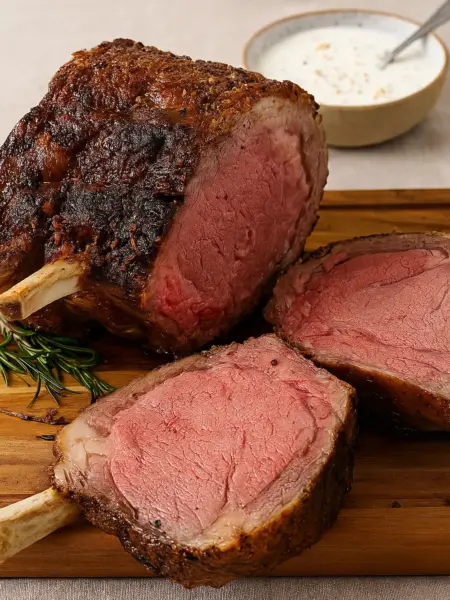This post may contain affiliate links, meaning I may earn a commission if you make a purchase, at no extra cost to you. I only recommend products I trust. Thank you for your support.
This crown roast of pork recipe features perfectly carved ribs roasted with garlic, herbs, and a golden crisp skin, filled with tender sausage and apple stuffing, and finished with a sweet, tangy whiskey glaze.
Serving up to 16 guests, it makes a stunning centerpiece for Christmas dinner, a grand Thanksgiving feast, Easter party, or even an elegant Sunday roast with extended family.
Although it looks extravagant, this crown pork roast recipe is surprisingly easy to prepare. With a little patience and the right technique, anyone can master this magnificent dish at home.
The real challenge isn’t the cooking itself, which mainly comes down to steady temperature control, but rather the advanced planning, such as arranging for the special cut from a reliable butcher.
Once the cut is secured and properly prepared, the cooking sequence itself is straightforward and requires attention rather than constant intervention.
This Christmas roast also pairs beautifully with a variety of sides, from roasted root vegetables and creamy mashed potatoes to glazed carrots or a crisp apple and fennel salad.
✅ Take a moment to read through the whole post for the ingredient list, expert tips, and equipment suggestions. The full recipe is right below!
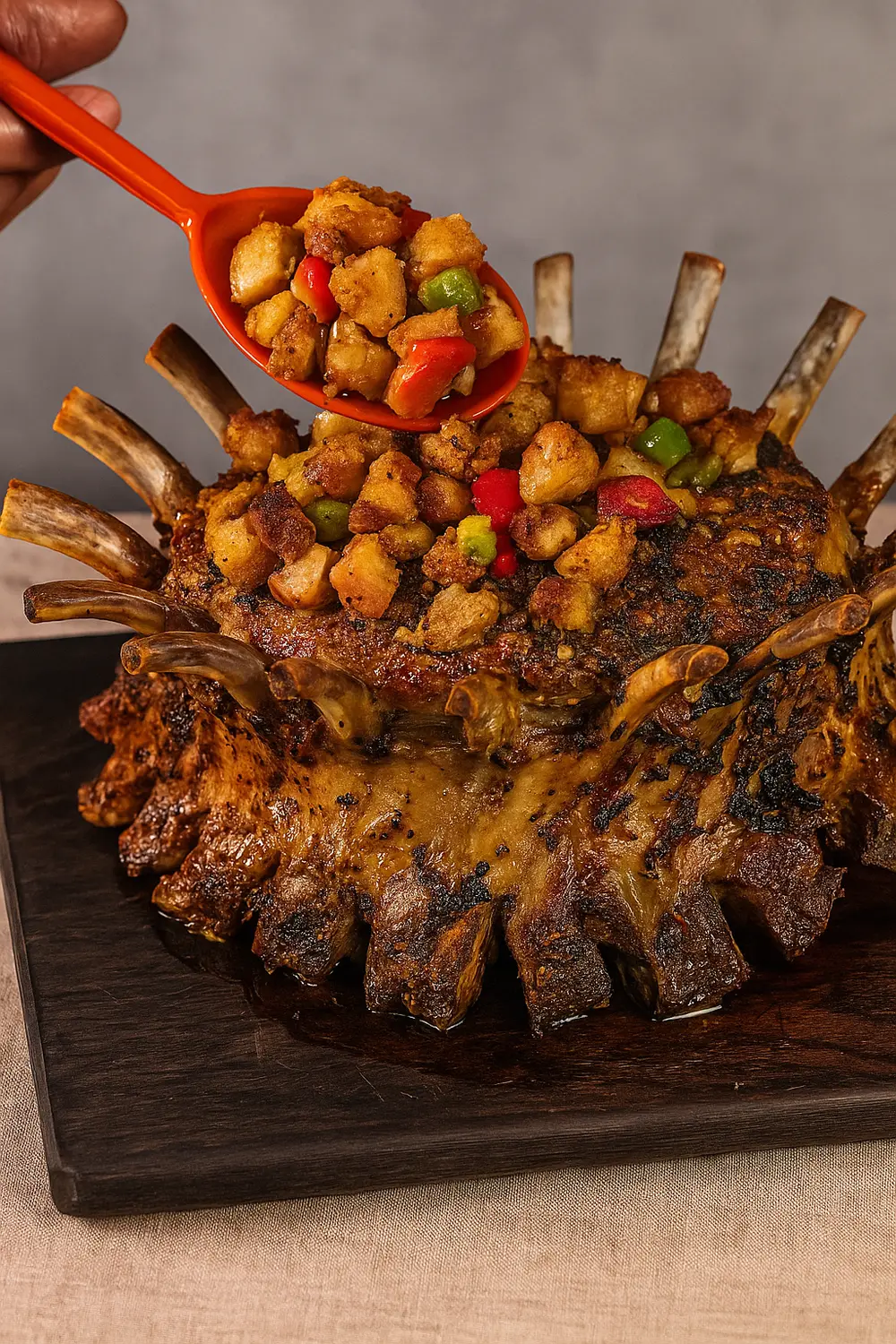
Key Ingredients You’ll Need for This Crown Roast of Pork Recipe
This pork roast recipe relies on a synergy of simple, high-quality ingredients, each playing a crucial role in the final flavor and texture.
1. The Crown Roast
- You will need bone-in pork loin (8 to 10 lbs, 16 to 18 ribs), carefully frenched and tied into a crown shape.
- The bones form the regal frame of the roast and create a cavity perfectly designed for holding savory stuffing.
2. Olive Oil
- A light drizzle of olive oil helps the seasoning paste cling evenly to the pork.
- As it roasts, the oil encourages caramelization, giving the roast its golden-brown, flavorful crust.
3. Garlic
- Fresh garlic infuses the roast with a rich, savory aroma that pairs beautifully with pork.
- As it roasts, the garlic softens in flavor and adds depth to every bite.
4. Fresh Herbs
- Festive holiday herbs such as rosemary, thyme, and sage bring earthiness, fragrance, and warmth to the roast.
- Together, they highlight the mild sweetness of the pork while filling the kitchen with seasonal aromas.
5. Dijon Mustard
- Dijon mustard adds a gentle tang that brightens the meat and ties the herbs and spices together.
- It also acts as a binder, helping the seasoning adhere firmly to the roast, and is also used for the herb glaze.
6. Crushed Fennel Seeds
- Fennel’s mild licorice note enhances the natural sweetness of pork without overpowering it.
- When crushed, the seeds release aromatic oils that add another layer of depth.
7. Salt & Pepper
- The most essential seasoning duo, salt penetrates the meat for balanced flavor throughout, while black pepper adds a subtle, peppery bite to the crust.
8. Italian Sausage
- Mild or spicy sausage forms the base of the stuffing.
- Its fat and spices infuse the bread and vegetables, creating a rich, savory contrast to the lean loin.
9. Apples
- Fresh apples bring a sweet and slightly tart note that lightens the richness of the stuffing.
- They also add moisture, complementing both the pork and the sausage.
10. Celery, Onions, and Carrots
- This aromatic trio builds the flavorful backbone of the stuffing.
- Celery lends freshness, onions provide natural sweetness, and carrots add a gentle earthiness.
11. Dried Cranberries & Pecans
- Cranberries bring bright pops of tartness, while pecans offer a nutty crunch.
- Together, they give the stuffing festive color, texture, and flavor.
12. Bread Cubes
- Day-old or lightly toasted bread provides the absorbent base for the stuffing.
- It soaks up the sausage drippings, stock, and aromatics, binding everything together.
13. Chicken or Pork Stock/Broth
- A gentle pour of warm stock keeps the stuffing moist and flavorful without becoming soggy.
- Whether you choose chicken or pork, the broth acts as the binding element, carrying the richness of the sausage, bread, and aromatics through every bite.
14. Whiskey, Apple Cider, and Honey
- This trio forms the base of the glaze, balancing sweet, tangy, and warming notes.
- Whiskey (Bourbon or Rye) adds depth, cider contributes acidity, and honey caramelizes beautifully during the final sear.
15. Worcestershire Sauce
- This classic condiment layers in deep umami flavor with hints of tamarind, vinegar, and molasses.
- Just a small splash enriches the glaze, balancing the sweetness of honey and cider while giving the roast a savory backbone that makes every bite more complex and satisfying.
16. Fresh Ginger
- Ginger adds a bright, warming spice that cuts through the glaze’s sweetness.
- Its zesty kick keeps the flavors lively and balanced.
17. Butter
- A final pat of butter whisked into the glaze gives it shine, richness, and a silky finish.
- It ties all the flavors together in a luxurious coating.
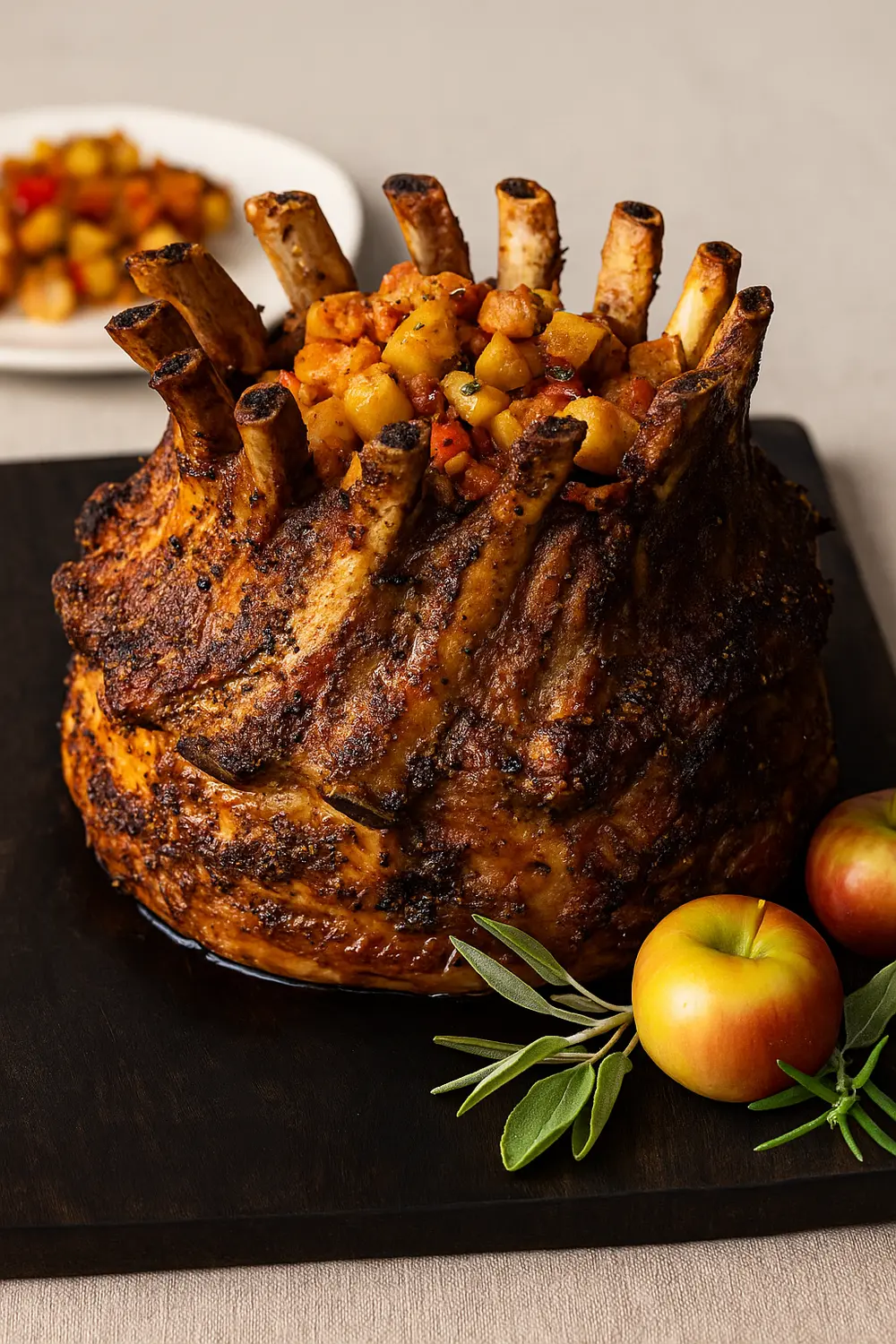
Kitchen Tools for Making This for Crown Pork Roast Recipe
While the crown roast of pork looks complicated, the equipment needed is standard for a serious Christmas roast. Using the right kitchen tools guarantees precise temperature control and presentation success:
- High-Quality Digital Instant-Read Meat Thermometer: A reliable digital instant-read meat thermometer is essential, as the success of this roast depends on reaching 140°F before searing and 145°F after resting.
- Large Roasting Pan: A sturdy roasting pan with a rack keeps the roast elevated, allowing hot air to circulate for even cooking and browning on all sides.
- Wire Rack: Placed inside the roasting pan, lifting the pork roast so that hot air circulates evenly, helping the bottom crisp just as well as the top, a key step in reverse searing.
- Aluminum Foil: Necessary for covering the delicate, frenched bone tips during the long roast, preventing them from charring and maintaining the beautiful, white presentation.
- Basting Brush: For applying the aromatic herb rub and, later, the festive Whiskey-Apple Glaze to achieve an even, glossy crust.
- Saucepan and Skillet: A medium saucepan is required for reducing the glaze, and a large skillet or Dutch oven is needed for cooking the savory sausage and apple stuffing.
- Butcher’s Twine and Frills: A strong butcher’s twine is essential for holding the crown roast together securely during cooking, and small paper frills are used to cap the bone tips for the final, elegant presentation.
- Chef’s Knife & Carving Knife: A sharp chef’s knife makes prep easier, while a carving knife delivers clean, elegant slices at the table.
Why You’ll Love This Christmas Roast
Choosing the crown roast of pork for your next holiday roast is a decision driven by taste, tradition, and also comes with a number of health benefits:
- Superior Juiciness and Flavor: Because the crown pork roast is made from thick, bone-in pork loin, the meat surrounding the bone is exceptionally juicy and flavorful.
- A Timeless Tradition: This cut is steeped in the history of celebratory feasts and banquets, where impressive displays of food were highly valued.
- High-Quality Protein: Pork loin is an excellent source of complete protein, providing between 22 grams and 25 grams per 3 to 4-ounce serving, which is vital for muscle maintenance and promoting satiety.
- Rich in B Vitamins: Pork is packed with B vitamins, which are crucial for energy metabolism. It is particularly high in Thiamin (Vitamin B1), Riboflavin (B2), and Niacin (B3).
- Source of Key Minerals: This Christmas pork roast supplies essential minerals like iron, which aids oxygen transport in the blood, zinc for immune function and cell growth, and potassium, an electrolyte that helps maintain healthy blood pressure.
- Low Carbohydrate Base: The pork meat itself is naturally carbohydrate-free, allowing for control over the total carbohydrate content through the accompanying stuffing and glaze.
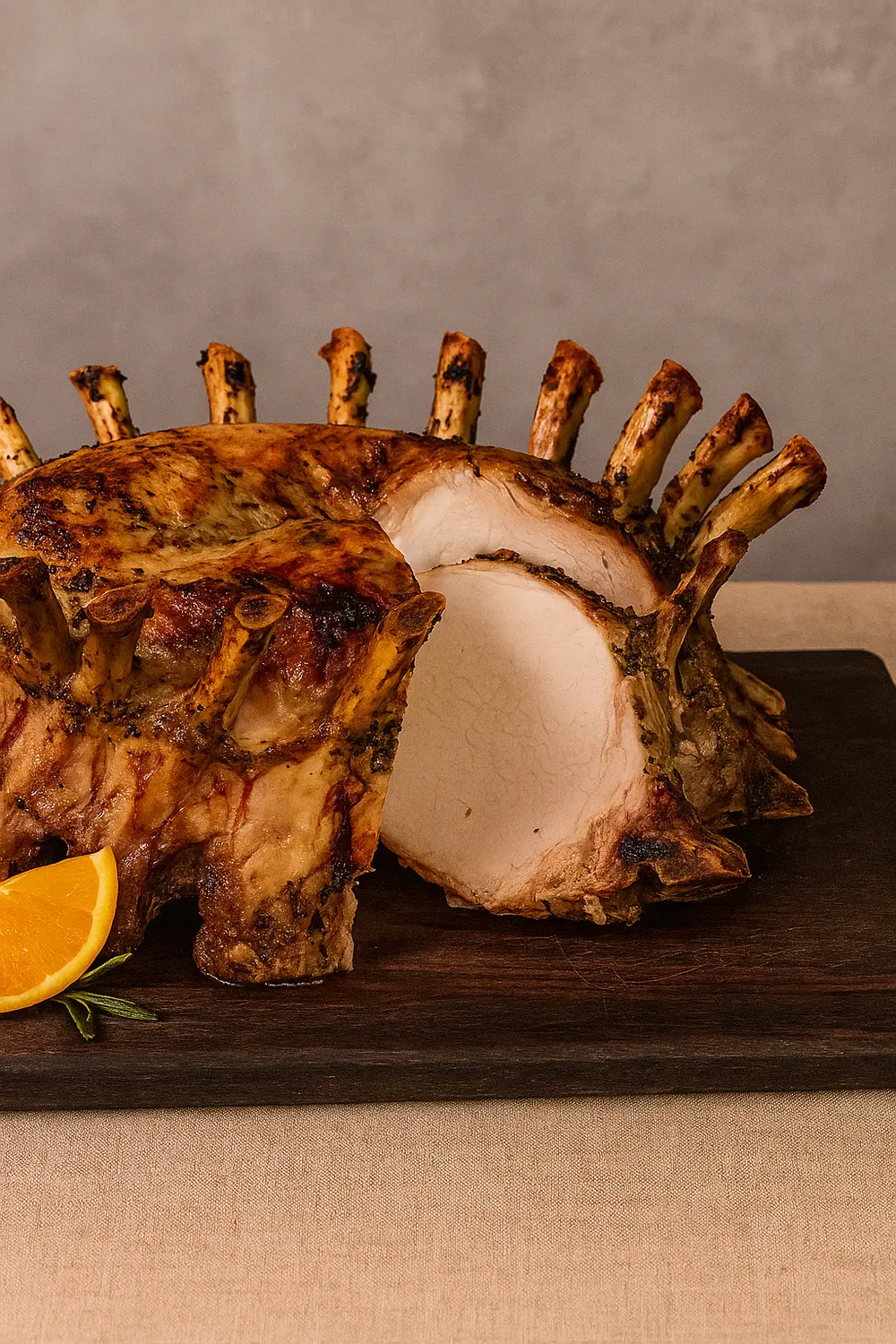
Chef Tips for Making the Best Pork Crown Roast
Creating the perfect crown pork roast depends on careful technique and a clear understanding of how heat moves through a large cut of meat.
1. Implement the Reverse Sear Technique
- Begin low and slow at 250°F (120°C) until the internal temperature reaches 140°F (60°C); this gentle cooking reduces the gray, dry band of overcooked meat near the surface.
- Then, after resting, finish it in a 500°F (260°C) oven for 8 to 10 minutes to achieve a crispy crust and caramelized glaze without overcooking the interior.
2. Monitor Temperature
- Use a reliable thermometer inserted into the thickest part of the loin, avoiding the bone, to ensure the pork reaches the safe and ideal internal temperature of 145°F (63°C), keeping it tender, juicy, and perfectly cooked.
3. Rest, Then Rest Again
- This recipe requires two resting periods, the first (15 to 45 minutes) happens after the low cook and before the high sear, allowing moisture to redistribute before the searing heat.
- The final 15-minute rest after searing to lock in the juices before carving the crown roast pork.
4. Precook the Stuffing
- For safety and optimal quality, always pre-cook the stuffing, as raw, moist stuffing can insulate and prevent reaching a safe temperature on its own.
- Add the hot, pre-cooked stuffing to the crown cavity only just before the final high-heat sear, or serve it entirely on the side.
5. Don’t Burn the Rib Bones
- Cap the tips of the frenched rib bones with small pieces of aluminum foil before cooking to prevent them from burning, then remove the foil just before the 500°F sear and add decorative frills, if desired, before serving.
Final Remarks
With its golden, crispy crust, tender and juicy meat, and a rich, flavorful glaze, this crown roast of pork is the ultimate centerpiece for any festive meal.
Feel free to customize the stuffing or glaze to suit your taste, add dried fruits, nuts, or fresh herbs for extra flavor and texture.
Serve it with roasted vegetables, creamy mashed potatoes, or a crisp green salad for a complete, show-stopping Christmas dinner feast.
If you try this pork roast recipe, we’d love to hear how it turned out, share your version, or your thoughts in the comments.
You’ll find the full recipe and step-by-step instructions just below.
Best Crown Roast of Pork Recipe for Christmas
In this crown roast of pork recipe, we cook the pork roast with the advanced reverse-sear technique for a tender, moist interior and an ultra-crisp exterior, then finish it with perfectly glazed ribs and a classic savory stuffing.
Ingredients
For the Crown Pork Roast
For the Herb & Garlic Rub
For the Stuffing
For the Whiskey Apple Glaze
How to Cook Pork Roast (Step-By-Step Instructions)
Season the Pork Roast
- Pat the pork roast completely dry with paper towels.
- In a small bowl, mix olive oil, minced garlic, rosemary, sage, thyme, Dijon mustard, crushed fennel seed, salt, and pepper to form a paste.
- Rub this seasoning paste generously over the entire roast, including inside the cavity and between the ribs.
- Cover the frenched bone tips with small pieces of aluminum foil to prevent them from burning during roasting.
- Let the seasoned roast rest at room temperature for 60 to 90 minutes.
Prepare the Stuffing
- Always cook the stuffing fully before placing it inside the crown roast to ensure food safety and even cooking.
- In a large skillet, melt butter and cook the Italian sausage, breaking it apart, until browned.
- Drain and set aside.
- Using the same skillet, sauté chopped onions, celery, and carrots until tender for about 15 minutes.
- Add diced apples and cook until they soften slightly for about 10 minutes.
- Stir in fresh herbs and spices, such as sage, thyme, and allspice.
- In a large mixing bowl, combine dried bread cubes, sausage, sautéed vegetables and apples, cranberries, and toasted pecans.
- Moisten the mixture with chicken stock until it is soft but not soggy.
- Season with salt and pepper.
- The stuffing can be kept warm or baked separately, then added to the crown cavity just before the final sear.
Low and Slow Roast (Reverse Sear Phase 1)
- Preheat the oven to 250°F (120°C).
- Place the crown pork roast on a wire rack set inside a shallow roasting pan.
- The rack helps air circulate for even cooking and crisping on the bottom.
- Insert a meat thermometer into the thickest part of the roast, making sure the probe does not touch bone.
- Roast the pork low and slow until the internal temperature reaches 140°F (60°C).
- For an 8 to 10-pound roast, this phase usually takes about 2 hours.
Rest the Pork Roast
- Once the roast reaches an internal temperature of 140°F (60°C), take it out of the oven right away.
- Tent the roast loosely with foil and let it rest for 15 to 45 minutes.
- This rest is essential for allowing the juices to redistribute through the meat.
- While the roast rests, increase the oven temperature to a high 500°F (260°C).
Glaze and Final Sear (Phase 2)
- While the oven heats to 500°F (260°C), prepare the glaze.
- In a medium saucepan, combine stock, cider, whiskey, honey, Dijon mustard, Worcestershire sauce, and ginger.
- Bring the mixture to a boil, then reduce to low and simmer until it reduces by about one-third, around 15 minutes.
- Remove from heat and whisk in 1 tablespoon unsalted butter for shine and richness.
- Once the oven is ready, take off the foil caps from the bones.
- If using stuffing, carefully spoon the hot, pre-cooked stuffing into the crown cavity.
- Brush the roast generously with the glaze, making sure to coat the ribs and stuffing surface.
- Return the roast to the oven for 8 to 10 minutes, basting once halfway through.
- This final high-heat blast caramelizes the glaze, crisps the exterior, and locks in the beautiful golden finish.
Rest and Serve
- Remove the roast once the surface is golden brown and beautifully caramelized.
- The final internal temperature should reach 145°F (63°C) after the sear.
- Tent the roast loosely with foil and allow it to rest for another 15 minutes.
- This step is non-negotiable, as it lets the juices redistribute evenly for maximum tenderness.
Serve
- Carefully snip and remove the butcher’s twine.
- Replace the foil caps with decorative paper frills or sprigs of rosemary for a festive presentation.
- Carve the crown roast of pork by slicing straight down between the ribs.
- Drizzle any remaining warm glaze over the carved slices just before serving for added shine and flavor.
Nutrition Facts
Servings 16
Serving Size Approximately 2 ribs (about 4 oz)
- Amount Per Serving
- Calories 450kcal
- % Daily Value *
- Total Fat 27g42%
- Saturated Fat 9g45%
- Cholesterol 100mg34%
- Sodium 490mg21%
- Potassium 650mg19%
- Total Carbohydrate 12g4%
- Dietary Fiber 2g8%
- Sugars 8g
- Protein 40g80%
- Vitamin A 100 IU
- Vitamin C 2 mg
- Calcium 35 mg
- Iron 4 mg
* Percent Daily Values are based on a 2,000 calorie diet. Your daily value may be higher or lower depending on your calorie needs.
Note
- Ask your butcher to prepare the roast frenched and securely tied, with 16 to 18 ribs, so it holds its crown shape during cooking.
- Let the seasoned roast sit at room temperature for about 90 minutes before cooking.
- Cap the frenched bone tips with aluminum foil before roasting to prevent burning.
- Insert the thermometer into the thickest part of the loin, ensuring it does not touch bone to avoid false high readings.
- Never cook raw stuffing inside the crown; bake it separately or add it only in the last 10 minutes of the sear.
- A 15-minute rest after cooking is essential, allowing the juices to redistribute for maximum tenderness.

